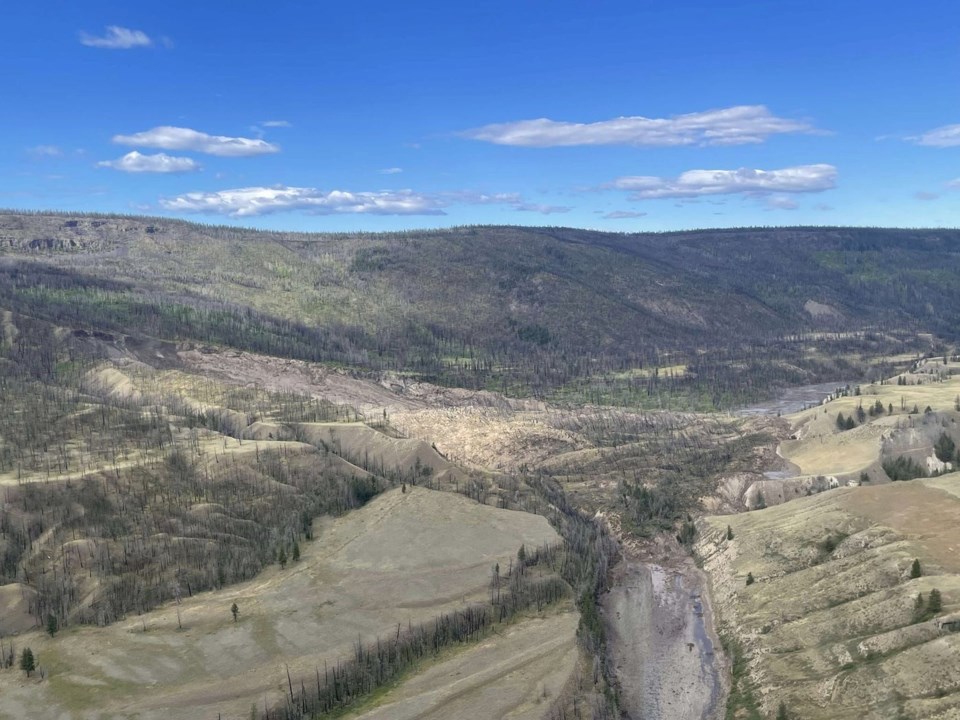WILLIAMS LAKE, B.C. — A landslide of debris piled 30 metres high and 600 metres long has dammed the Chilcotin River in British Columbia's central Interior, creating a lake that officials say could give way.
They say the sudden rush of water could set off dozens of evacuation orders and alerts downstream.
Margo Wagner, chair of the Cariboo Regional District, said Thursday that the water building up behind the slide south of the City of Williams Lake could reach a level where it will start flowing over the debris, or it will erode the material, setting off a release.
"As the water continues to flow and builds up behind that landslide, the pressure increases, but we do not have a definitive time of when that will let go," she told a media briefing.
Officials have estimated a release could come Friday or Saturday, she said.
Wagner said the riverbed below the slide is dry, and officials aren't certain about the potential downstream impacts when the dam is breached.
But she said it's clear there would be "a mass of water" coming down the Chilcotin, which flows south into the Fraser River.
"We don't know exactly when this landslide is going to give way. We are hearing that it's expected between 24 to 48 hours," she said during the briefing.
The slide is "massive," Wagner added.
Wagner said they aren't aware of any injuries except to one man who broke his leg while he was running away from the slide, which struck late Tuesday or early Wednesday.
The nearby Tsilhqot’in National Government declared a state of local emergency Thursday and warned people to stay away from the river.
A statement said the "situation is changing rapidly with many unknowns" and flooding has the potential to threaten bridges to two communities.
"At this time, we don’t know what each day will bring — but we are prepared and have managed emergencies over thousands of years, including several slides blocking the river in my lifetime," Chief Joe Alphonse said in the statement.
Minister of Emergency Management Bowinn Ma told a separate news conference Thursday that if the dam were to break it's possible that dozens of evacuation orders and alerts would be issued along both rivers and "people need to be prepared."
"Let me be clear, the risk to people and communities along the river is unknown at this time, but it has the potential to be significant," she said.
She said engineers, geologists and hydrologists are on site and in the air assessing the landslide and working to understand the potential impacts downstream.
The minister said people living along the Chilcotin and Fraser rivers for hundreds of kilometres, to Hope, at the eastern end of B.C.'s Fraser Valley, are encouraged to pack and prepare their home for possible flooding by moving equipment and other assets from low lying areas.
Ma said anyone planning to be on a boat on the Fraser needs to rethink that, and people must stay away from the shoreline between Hope and the confluence of the Chilcotin, as a gush of water and debris can make the banks unstable.
Evacuation orders span 107 square kilometres along the Chilcotin, which the district said involves 60 properties, including 12 homes with an estimated 13 residents.
Wagner said the landslide happened in an area that was "burned out" during wildfires in 2017.
"There is a lot of area (where) the trees are dead. They are still standing, but their root system is totally done, and they are not absorbing water, which is an issue."
Dwayne Tannant, a geotechnical engineering professor at UBC Okanagan, said the topography in the region is "prone to landslides" and while the 2017 fires are likely to have been a factor, he doesn't believe it was the main cause.
"I'm thinking it's more than the wildfire. It's the geology, topography and total erosion that are probably the key drivers here," he said, noting the slide was not a preventable event.
"It wouldn't be an economical use of provincial resources to do anything, particularly given the scale of this slide and where it's located," he said when asked about mitigation.
Tannant said a river-blocking landslide is "relatively rare," but officials should be concerned that slopes upstream of the blockage could become destabilized once the dam breaks, potentially creating a "domino effect," of other landslides.
"I think that's a remote possibility, but it should be given some consideration," he said.
B.C.'s River Forecast Centre has issued a flood warning for the Chilcotin north of the slide, saying the debris is "creating a lake" that extends several kilometres upstream.
The forecast centre says the eventual breach of the landslide debris could also lead to an "outburst flood" with a surge of water rapidly flowing downstream.
In the event of a breach, the forecast centre says the surge could reach the Fraser River within hours, and while flooding south of the Fraser Canyon would likely be less severe, substantial increases in flow could extend to the mouth of the river in Metro Vancouver.
A flood watch has been posted downstream of the Chilcotin and Fraser rivers to Hope, while a high streamflow advisory has been issued for the Fraser River right through to the mouth of the river in Metro Vancouver.
Ma said there are worries that a sudden release of debris could cause additional erosion as it moves down the river, as well as concerns about what impact the blocked water is having on salmon.
"There are also concerns that persistent low water levels might impact navigation channels for fish like the ongoing chinook run and the sockeye run coming up," she said.
"Those can have significant impacts on the ecology of the river system."
This report by The Canadian Press was first published Aug. 1, 2024.
The Canadian Press



